‘X-Currents’ and Extreme Brightening in Dayside Aurora
Abstract
1. Introduction
2. Materials and Methods
3. Results
3.1. 18 December 2017
3.2. 6 December 2018
3.3. 31 December 2018
4. Discussion
5. Conclusions
Author Contributions
Funding
Data Availability Statement
Acknowledgments
Conflicts of Interest
References
- Frey, H.; Han, D.-S.; Kataoka, R.; Lessard, M.; Milan, S.; Nishimura, Y.; Strangeway, R.; Zou, Y. Dayside Aurora. Space Sci. Rev. 2019, 215, 51. [Google Scholar] [CrossRef]
- Hosokawa, K.; Kullen, A.; Milan, S.; Reidy, J.; Zou, Y.; Frey, H.U.; Maggiolo, R.; Fear, R. Aurora in the Polar Cap: A Review. Space Sci. Rev. 2020, 216, 15. [Google Scholar] [CrossRef]
- Zhang, J.; Temmer, M.; Gopalswamy, N.; Malandraki, O.; Nitta, N.V.; Patsourakos, S.; Shen, F.; Vršnak, B.; Wang, Y.; Webb, D.; et al. Earth-affecting solar transients: A review of progresses in solar cycle 24. Prog. Earth Planet. Sci. 2021, 8, 56. [Google Scholar] [CrossRef] [PubMed]
- Burlaga, L.; Sittler, E.; Mariani, F.; Schwenn, R. Magnetic loop behind an interplanetary shock: Voyager, Helios, and IMP 8 observations. J. Geophys. Res. 1981, 86, 6673. [Google Scholar] [CrossRef]
- Sandholt, P.E.; Farrugia, C.J.; Moen, J.; Noraberg, Ø.; Lybekk, B.; Sten, T.; Hansen, T. A classification of dayside auroral forms and activities as a function of interplanetary magnetic field orientation. J. Geophys. Res. Space Phys. 1998, 103, 23325–23345. [Google Scholar] [CrossRef]
- Øieroset, M.; Sandholt, P.E.; Denig, W.F.; Cowley, S.W.H. Northward interplanetary magnetic field cusp aurora and high-latitude magnetopause reconnection. J. Geophys. Res. Space Phys. 1997, 102, 11349–11362. [Google Scholar] [CrossRef]
- Sandholt, E.; Farrugia, C.J.; Cowley, S.W.H.; Lester, M.; Denig, W.F.; Cerisier, J.-C.; Milan, S.E.; Moen, J.; Trondsen, E.; Lybekk, B. Dynamic cusp aurora and associated pulsed reverse convection during northward interplanetary magnetic field. J. Geophys. Res. Space Phys. 2000, 105, 12869–12894. [Google Scholar] [CrossRef]
- Sandholt, E.; Farrugia, C.J.; Cowley, S.W.H.; Lester, M.; Cerisier, J.C. Excitation of transient lobe cell convection and auroral arc at the cusp poleward boundary during a transition of the interplanetary magnetic field from south to north. Ann. Geophys. 2001, 19, 487–493. [Google Scholar] [CrossRef]
- Sandholt, E.; Farrugia, C.J.; Øieroset, M.; Stauning, P.; Cowley, S.W.H. Auroral signature of lobe reconnection. Geophys. Res. Lett. 1996, 23, 1725–1728. [Google Scholar] [CrossRef]
- Sandholt, E.; Farrugia, C.; Denig, W. Dayside Aurora and the Role of IMF\By\/\Bz\: Detailed Morphology and Response to Magnetopause Reconnection. Ann. Geophys. 2004, 22, 613–628. [Google Scholar] [CrossRef][Green Version]
- Lockwood, M.; Moen, J. Reconfiguration and closure of lobe flux by reconnection during northward IMF: Possible evidence for signatures in cusp/cleft auroral emissions. Ann. Geophys. 1999, 17, 996–1011. [Google Scholar] [CrossRef]
- Sandholt, E.; Farrugia, C.J.; Cowley, S.W.H.; Denig, W.F.; Lester, M.; Moen, J.; Lybekk, B. Capture of magnetosheath plasma by the magnetosphere during northward IMF. Geophys. Res. Lett. 1999, 26, 2833–2836. [Google Scholar] [CrossRef]
- Sandholt, E.; Farrugia, C.J.; Burlaga, L.F.; Holtet, J.A.; Moen, J.; Lybekk, B.; Jacobsen, B.; Opsvik, D.; Egeland, A.; Lepping, R.; et al. Cusp/cleft auroral activity in relation to solar wind dynamic pressure, interplanetary magnetic field Bz and By. J. Geophys. Res. Space Phys. 1994, 99, 17323–17342. [Google Scholar] [CrossRef]
- Horwitz, J.L.; Akasofu, S.-I. The response of the dayside aurora to sharp northward and southward transitions of the interplanetary magnetic field and to magnetospheric substorms. J. Geophys. Res. 1977, 82, 2723–2734. [Google Scholar] [CrossRef]
- Rairden, R.L.; Mende, S.B. Properties of 6300-Å auroral emissions at South Pole. J. Geophys. Res. Space Phys. 1989, 94, 1402–1416. [Google Scholar] [CrossRef]
- Fasel, G.J.; Lee, L.C.; Smith, R.W. A mechanism for the multiple brightenings of dayside poleward-moving auroral forms. Geophys. Res. Lett. 1993, 20, 2247–2250. [Google Scholar] [CrossRef]
- Fasel, G.J. Dayside poleward moving auroral forms: A statistical study. J. Geophys. Res. Space Phys. 1995, 100, 11891–11905. [Google Scholar] [CrossRef]
- Xing, Z.Y.; Yang, H.G.; Han, D.S.; Wu, Z.S.; Hu, Z.J.; Zhang, Q.H.; Kamide, Y.; Hu, H.Q.; Zhang, B.C.; Liu, J.M.; et al. Poleward moving auroral forms (PMAFs) observed at the Yellow River Station: A statistical study of its dependence on the solar wind conditions. J. Atmos. Sol.-Terr. Phys. 2012, 86, 25–33. [Google Scholar] [CrossRef]
- Drury, E.E.; Mende, S.B.; Frey, H.U.; Doolittle, J.H. Southern Hemisphere poleward moving auroral forms. J. Geophys. Res. Space Phys. 2003, 108, 1114. [Google Scholar] [CrossRef]
- Sandholt, P.E.; Farrugia, C.J. Poleward moving auroral forms (PMAFs) revisited: Responses of aurorae, plasma convection and Birkeland currents in the pre- and postnoon sectors under positive and negative IMF By conditions. Ann. Geophys. 2007, 25, 1629–1652. [Google Scholar] [CrossRef]
- Sandholt, P.E.; Farrugia, C.J.; Moen, J.; Cowley, S.W.H.; Lybekk, B. Dynamics of the aurora and associated convection currents during a cusp bifurcation event. Geophys. Res. Lett. 1998, 25, 4313–4316. [Google Scholar] [CrossRef]
- Carter, J.A.; Milan, S.E.; Fear, R.C.; Kullen, A.; Hairston, M.R. Dayside reconnection under interplanetary magnetic field By-dominated conditions: The formation and movement of bending arcs. J. Geophys. Res. Space Phys. 2015, 120, 2967–2978. [Google Scholar] [CrossRef][Green Version]
- Frey, H.U.; Mende, S.B.; Immel, T.J.; Fuselier, S.A.; Claflin, E.S.; Gérard, J.-C.; Hubert, B. Proton aurora in the cusp. J. Geophys. Res. Space Phys. 2002, 107, SMP 2-1–SMP 2-17. [Google Scholar] [CrossRef]
- Fear, R.C.; Milan, S.E.; Carter, J.A.; Maggiolo, R. The interaction between transpolar arcs and cusp spots. Geophys. Res. Lett. 2015, 42, 9685–9693. [Google Scholar] [CrossRef]
- Milan, S.E.; Evans, T.A.; Hubert, B. Average auroral configuration parameterized by geomagnetic activity and solar wind conditions. Ann. Geophys. 2010, 28, 1003–1012. [Google Scholar] [CrossRef]
- Han, D.-S.; Hietala, H.; Chen, X.C.; Nishimura, Y.; Lyons, L.R.; Liu, J.J.; Hu, H.Q.; Yang, H.G. Observational properties of dayside throat aurora and implications on the possible generation mechanisms. J. Geophys. Res. Space Phys. 2017, 122, 1853–1870. [Google Scholar] [CrossRef]
- Han, D.-S.; Nishimura, Y.; Lyons, L.R.; Hu, H.Q.; Yang, H.G. Throat aurora: The ionospheric signature of magnetosheath particles penetrating into the magnetosphere. Geophys. Res. Lett. 2016, 43, 1819–1827. [Google Scholar] [CrossRef]
- Han, D.-S.; Xu, T.; Jin, Y.; Oksavik, K.; Chen, X.C.; Liu, J.J.; Zhang, Q.; Baddeley, L.; Herlingshaw, K. Observational Evidence for Throat Aurora Being Associated With Magnetopause Reconnection. Geophys. Res. Lett. 2019, 46, 7113–7120. [Google Scholar] [CrossRef]
- Rodriguez, J.V.; Carlson, H.C.; Heelis, R.A. Auroral forms that extend equatorward from the persistent midday aurora during geomagnetically quiet periods. J. Atmos. Sol.-Terr. Phys. 2012, 86, 6–24. [Google Scholar] [CrossRef]
- Tanskanen, E.I. A comprehensive high-throughput analysis of substorms observed by IMAGE magnetometer network: Years 1993–2003 examined. J. Geophys. Res. Space Phys. 2009, 114. [Google Scholar] [CrossRef]
- Fasel, G.J.; Lee, L.C.; Lake, E.; Csonge, D.; Yonano, B.; Bradley, O.; Briggs, J.; Lee, S.H.; Mann, J.; Sigernes, F.; et al. Correlation between the solar wind speed and the passage of poleward-moving auroral forms into the polar cap. Front. Astron. Space Sci. 2024, 10, 1233060. [Google Scholar] [CrossRef]
- Zhou, X.Y.; Fukui, K.; Carlson, H.C.; Moen, J.I.; Strangeway, R.J. Shock aurora: Ground-based imager observations. J. Geophys. Res. Space Phys. 2009, 114, A12216. [Google Scholar] [CrossRef]
- Sigernes, F.; Syrjasuo, M.; Ellingsen, P.G.; Lybekk, B.; Trondsen, E.; Clausen, L.; Moen, J.; Mattanen, J.; Kauristie, K. Status: The Boreal Aurora Camera Constellation (BACC); UNIS: Longyearbyen, Svalbard and Jan Mayen, 2017; pp. 1–15. [Google Scholar]
- Twitty, C.; Phan, T.D.; Paschmann, G.; Lavraud, B.; Rème, H.; Dunlop, M. Cluster survey of cusp reconnection and its IMF dependence. Geophys. Res. Lett. 2004, 31, L19808. [Google Scholar] [CrossRef]
- Briggs, J.K.; Fasel, G.J.; Silveira, M.; Sibeck, D.G.; Lin, Y.; Sigernes, F. Dayside Auroral Observation Resulting From a Rapid Localized Compression of the Earth’s Magnetic Field. Geophys. Res. Lett. 2020, 47, e2020GL088995. [Google Scholar] [CrossRef]
- Trattner, K.; Fuselier, S.A.; Petrinec, S.M. Location of the reconnection line for northward interplanetary magnetic field. J. Geophys. Res. Space Phys. 2004, 109, A03219. [Google Scholar] [CrossRef]
- Cowley, S.W.H. Magnetosphere-Ionosphere Interactions: A Tutorial Review. In Magnetospheric Current Systems; American Geophysical Union: Washington, DC, USA, 2000; pp. 91–106. [Google Scholar] [CrossRef]
- Lanzerotti, L.J.; Lee, L.C.; Maclennan, C.G.; Wolfe, A.; Medford, L.V. Possible evidence of flux transfer events in the polar ionosphere. Geophys. Res. Lett. 1986, 13, 1089–1092. [Google Scholar] [CrossRef]

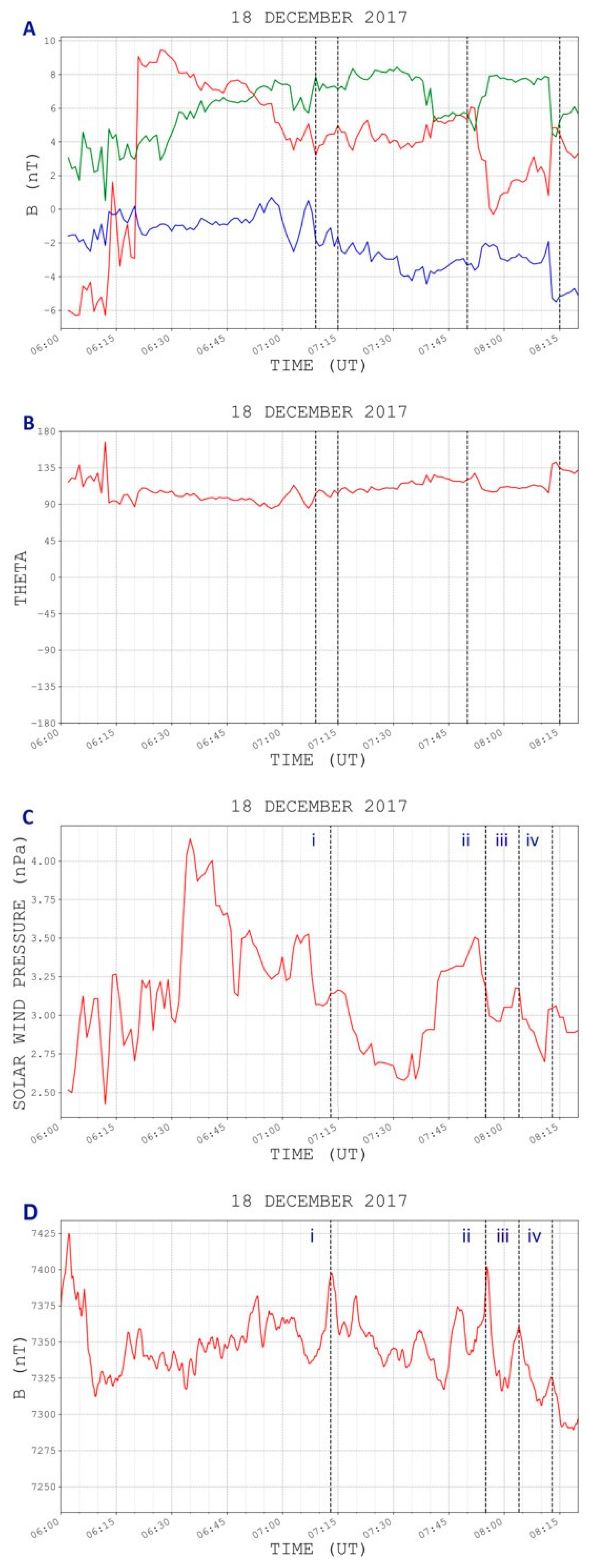
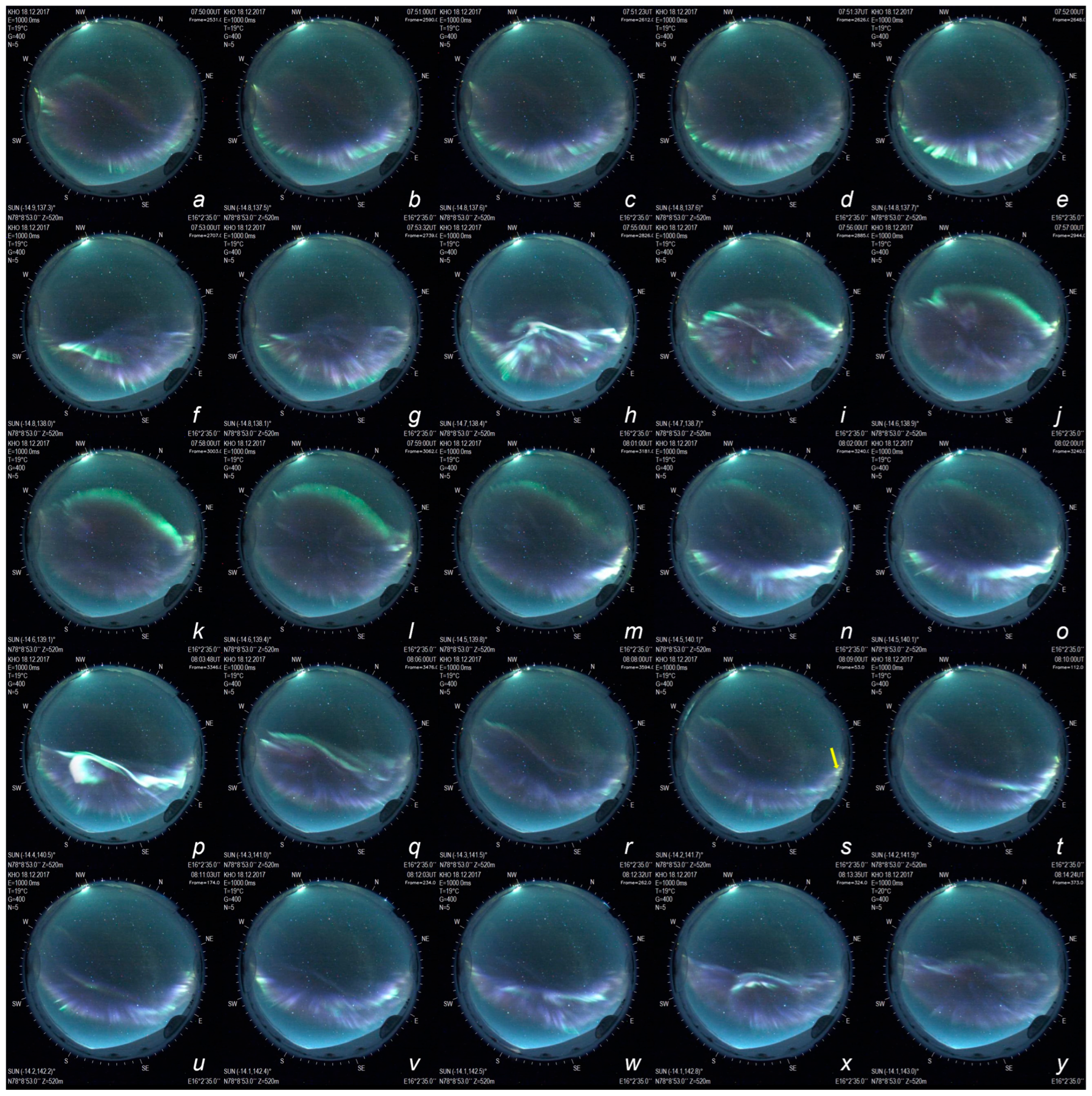

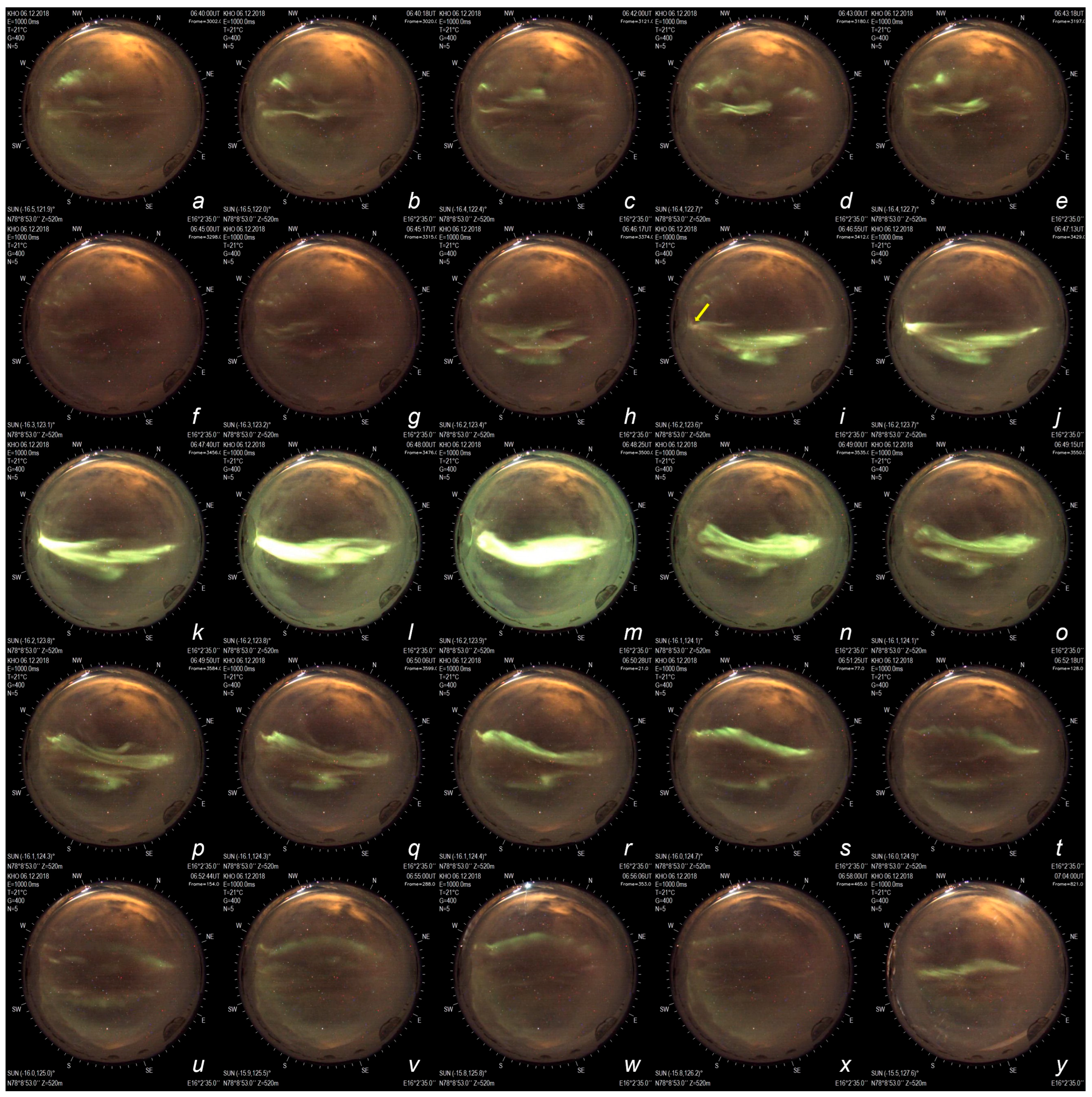
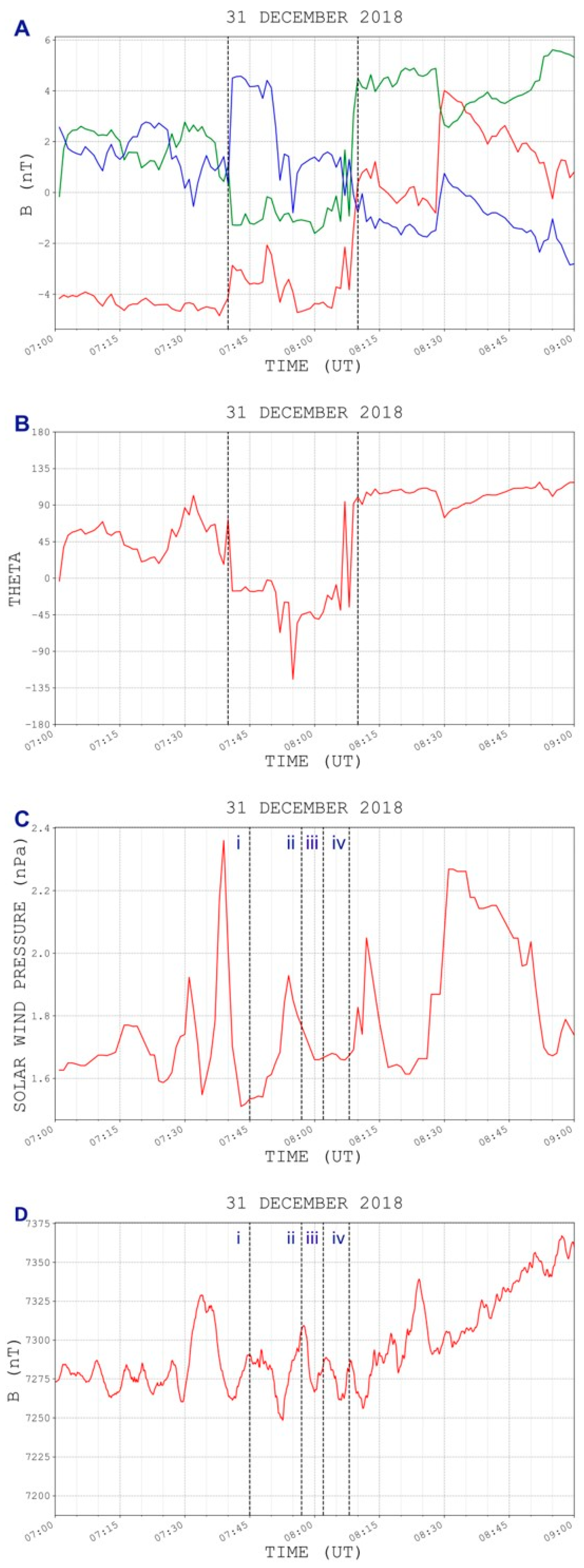
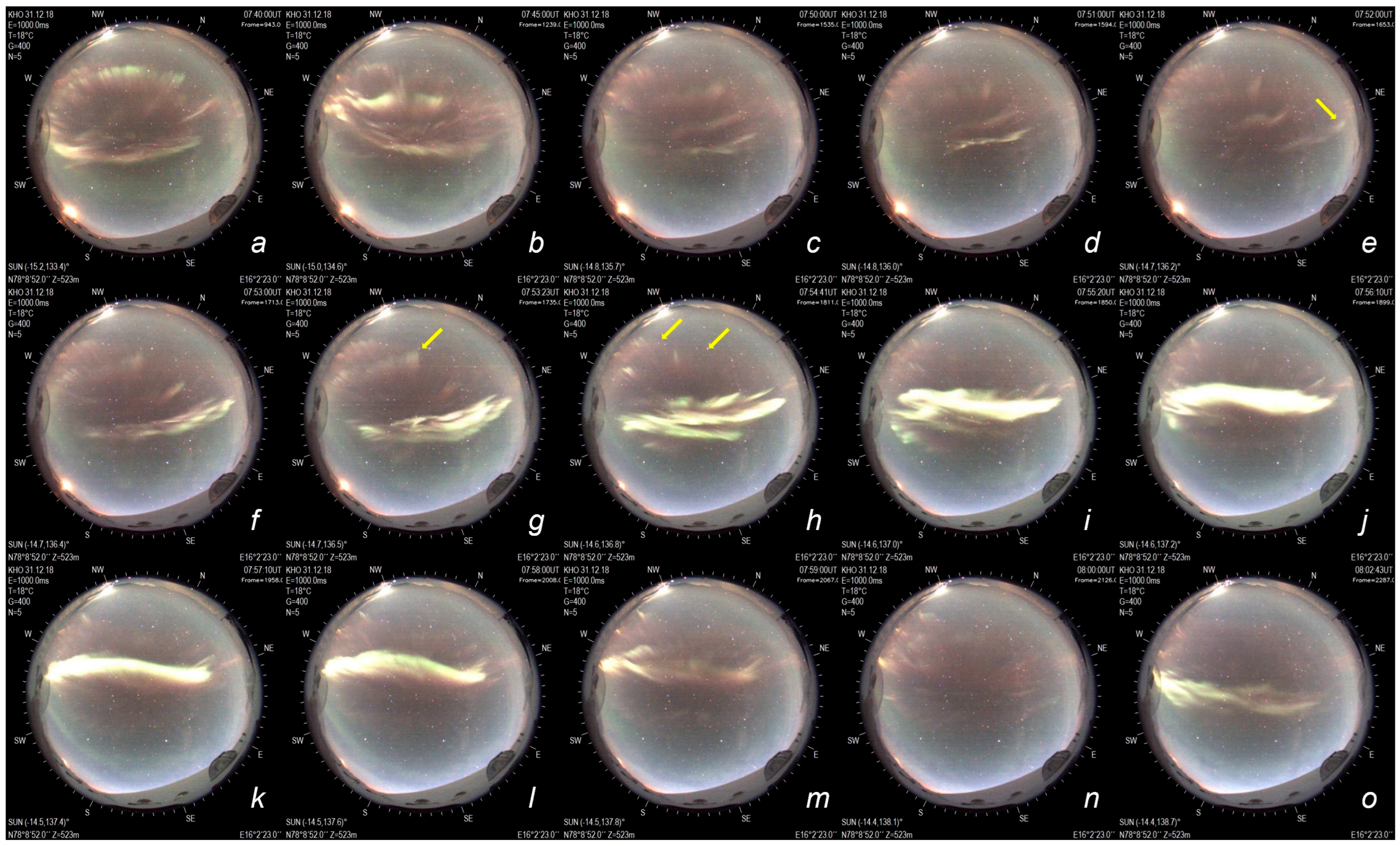
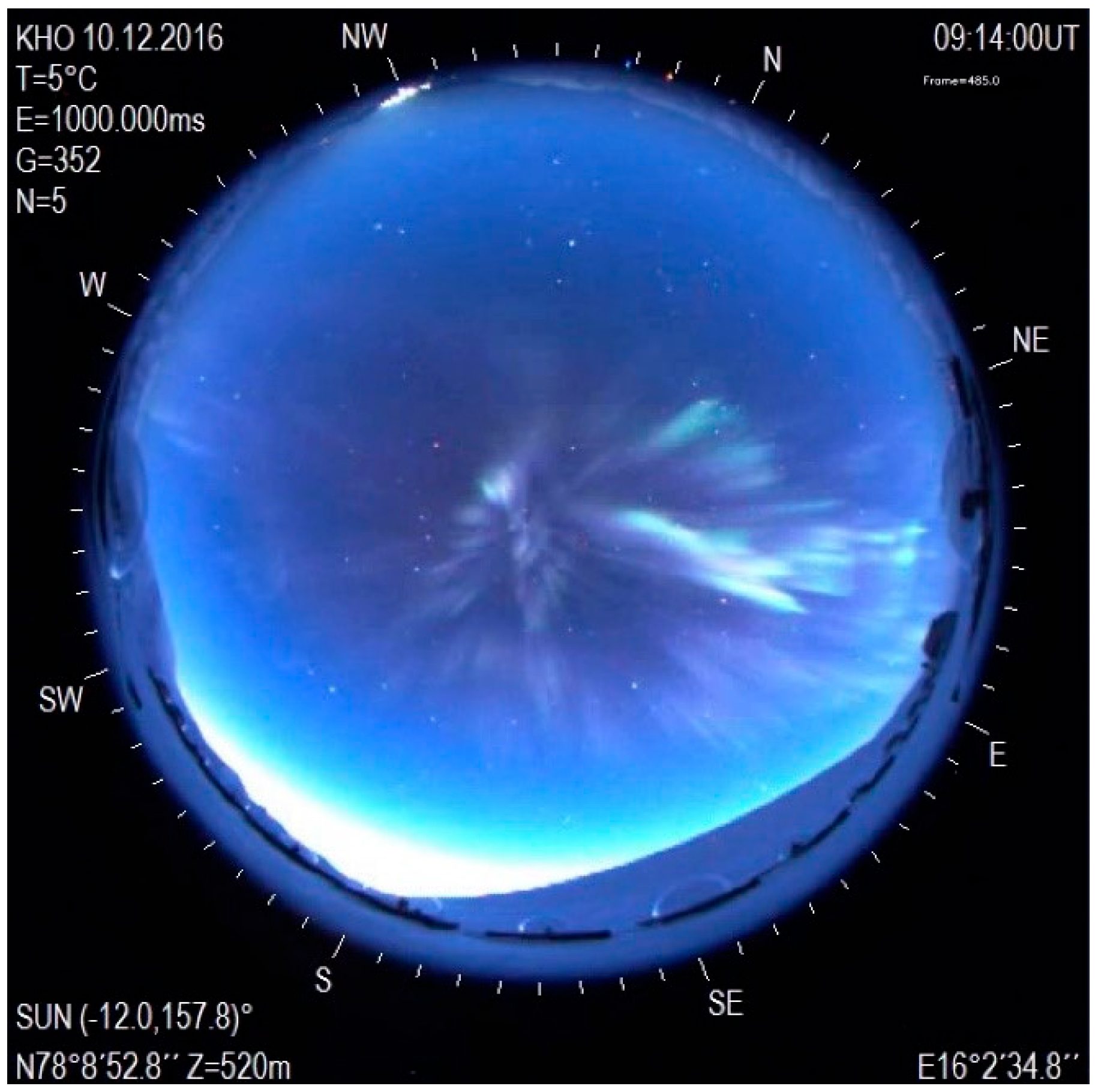
Disclaimer/Publisher’s Note: The statements, opinions and data contained in all publications are solely those of the individual author(s) and contributor(s) and not of MDPI and/or the editor(s). MDPI and/or the editor(s) disclaim responsibility for any injury to people or property resulting from any ideas, methods, instructions or products referred to in the content. |
© 2024 by the authors. Licensee MDPI, Basel, Switzerland. This article is an open access article distributed under the terms and conditions of the Creative Commons Attribution (CC BY) license (https://creativecommons.org/licenses/by/4.0/).
Share and Cite
Fasel, G.; Wang, A.; Daucher, A.; Lee, L.-C.; Pepperdine, J.; Bradley, O.; Mann, J.; Kim, M.; Swonger, B.; Sigernes, F.; et al. ‘X-Currents’ and Extreme Brightening in Dayside Aurora. Universe 2024, 10, 216. https://doi.org/10.3390/universe10050216
Fasel G, Wang A, Daucher A, Lee L-C, Pepperdine J, Bradley O, Mann J, Kim M, Swonger B, Sigernes F, et al. ‘X-Currents’ and Extreme Brightening in Dayside Aurora. Universe. 2024; 10(5):216. https://doi.org/10.3390/universe10050216
Chicago/Turabian StyleFasel, Gerard, Abrielle Wang, Audrey Daucher, Lou-Chuang Lee, Julia Pepperdine, Owen Bradley, John Mann, Minji Kim, Benjamin Swonger, Fred Sigernes, and et al. 2024. "‘X-Currents’ and Extreme Brightening in Dayside Aurora" Universe 10, no. 5: 216. https://doi.org/10.3390/universe10050216
APA StyleFasel, G., Wang, A., Daucher, A., Lee, L.-C., Pepperdine, J., Bradley, O., Mann, J., Kim, M., Swonger, B., Sigernes, F., & Lorentzen, D. (2024). ‘X-Currents’ and Extreme Brightening in Dayside Aurora. Universe, 10(5), 216. https://doi.org/10.3390/universe10050216





